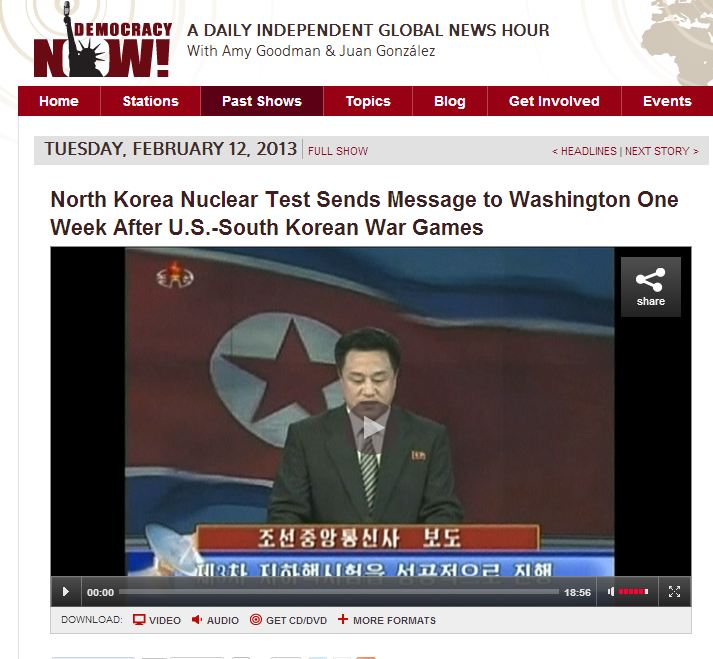 I was on Democracy Now! this morning talking about the latest North Korean nuclear test and its implications for U.S. policy. As usual, I spoke out for direct U.S. negotiations with the DPRK and called for a halt in the U.S.-South Korean military exercises that the North considers provocative and a threat to its sovereignty. You can see the interview here.
I was on Democracy Now! this morning talking about the latest North Korean nuclear test and its implications for U.S. policy. As usual, I spoke out for direct U.S. negotiations with the DPRK and called for a halt in the U.S.-South Korean military exercises that the North considers provocative and a threat to its sovereignty. You can see the interview here.
Meanwhile, an organization I’m affiliated with – the U.S. Working Group for Peace and Demilitarization in Asia and the Pacific – today issued a statement on the nuclear tests and what the United States might do to de-escalate the situation and bring about a final end to the Korean War. It’s pretty comprehensive and speaks for itself. As we say in the preface,
The contexts in which the test took place are complex, and there are actions that we and our governments can take to contribute to peace and denuclearization of Northeast Asia. including the need for the U.S. and other nuclear powers to cease their nuclear double standards and calling a halt to provocative war games, including those now under way.
U.S. Working Group for Peace & Demilitarization in Asia and the Pacific
Statement in Response to Third DPRK Nuclear Explosive Test
1. We come from diverse backgrounds and hold a range of analyses (or perspectives) approaching the North Korean nuclear weapons test and the further militarization of Asia and the Pacific.
2. We oppose the development, possession of, and threats to use nuclear weapons by any nation. We are committed to creating a world free of nuclear weapons. We have deep concerns that North Korea’s third nuclear weapons test contributes to an increasingly dangerous region-wide nuclear arms race. We understand the North Korean test was part of a cycle of threat and response to previous U.S. nuclear threats, and to continued military provocations. We cannot ignore the double standards and hypocrisies of the members of the “nuclear club” who refuse to fulfill their Article VI disarmament commitments of the Nuclear Nonproliferation Treaty commitments by “modernizing” their omnicidal arsenals while insisting that other nations refrain from becoming nuclear powers. North Korea has conducted three explosive nuclear tests, compared to the United States’ 1,054.
3. We note that beginning with the Korean War, the United States has prepared and threatened to attack North Korea with nuclear weapons at least nine times, that it maintains the so-called U.S. “nuclear umbrella” over Northeast Asia, and that its current contingency plans for war with North Korea include a possible first-strike nuclear attack.
4. The Obama administration’s first-term policy of “strategic patience” with the DPRK, reinforced by crippling sanctions that contribute to widespread malnutrition, connected to the stunting of growth in children and starvation, has proven to be a grave failure. The policy has foreclosed crucial opportunities to explore diplomacy and engagement. “Strategic patience”, combined with North and South Korea’s increasingly advanced missile programs, aggressive annual U.S.-South Korean military exercises – including preparations for the military overthrow of the DPRK government – and the Obama Administration’s militarized Asia-Pacific “pivot,”contributed to the DPRK’s decision to conduct a third nuclear “test.”
5. Added to these factors was the January 22, 2013 UN Security Council resolutions condemning North Korea’s December rocket launch and the tightening of the existing punitive sanctions program against North Korea. The double standard that permits all of North Korea’s neighbors and the United States to test and possess missiles, space launch, and military space technologies and to threaten the use of their missiles is extraordinary. It thus came as little surprise that the DPRK respondedby announcing plans for new nuclear tests that provocatively “target” the United States. Numerous analysts interpreted the announcement of a possible test as a means to break through the Obama Administration’s failed policy of “strategic patience” in order to bring the U.S. to the table for direct U.S.-DPRK negotiations.
6. 2013 marks the sixtieth year since the signing of the 1953 Armistice Agreement, which established a ceasefire but did not end the Korean War. We join Koreans around the world who call for Year One of Peace on the Korean Peninsula, as well as our partners across Asia and the Pacific who have designated 2013 as the Year of Asia-Pacific Peace and Demilitarization. Peaceful relations between the United States and North Korea (DPRK) are possible and they are more urgent than ever.
Given that unending war remains the basis of U.S.-DPRK relations, which have destabilized the lives of ordinary Korean people and been used to help justify the obscenely large Pentagon budget (equal to the spending of the next 13 largest military spenders – combined!)at the expense of U.S. citizens, we believe it is in the interests of the U.S. and North Korean peoples for our governments to begin negotiations to end the Korean War and leading to the eventual demilitarization and denuclearization of the Korean Peninsula. Peace is possible. We recall that, as recently as 2000, the Clinton Administration came within a hair’s breadth of completing a comprehensive agreement with North Korea, which was derailed by U.S. domestic political crisis over the outcome of the presidential election.
7. In this moment of escalation, we call for proactive measures by the U.S. government as an active party to this crisis. In order to stanch the dangerous nuclear, high-tech, and conventional arms races in Asia and the Pacific, we urge the following:
- Direct U.S.-DPRK negotiations
- Suspension of aggressive military exercises by all parties involved in tensions related to the Koreas
- An end to the UN-led punitive sanctions regime against the DPRK, which hurts/devastates? the lives of the North Korean people.
- An end to the Korean War by replacing the 1953 Armistice Agreement with a peace treaty
- Negotiations leading to the creation of a Northeast Asia Nuclear Weapons Free Zone
- An end to the U.S. first-strike nuclear weapons doctrine and a reversal of U.S. plans to spend an additional $185 billion over the next decade to “modernize” the U.S. nuclear arsenal and nuclear weapons delivery systems (missiles, bombers, etc.)
- Commence negotiations on a nuclear weapons abolition convention that requires the phased elimination of all nuclear weapons within a time bound framework, with provisions for effective verification and enforcement.
Working Group Members:
Christine Ahn , Gretchen Alther, Rev. Levi Bautista, Jackie Cabasso, Herbert Docena, John Feffer, Bruce Gagnon, Gerson, Subrata Goshoroy, Mark Harrison, Christine Hong, Kyle Kajihiro, Aura Kanegis, Peter Kuznick, Hyun Lee, Ramsay Liem, Andrew Lichterman, John Lindsay-Poland, Ngo Vinh Long, Kevin Martin, Stephen McNeil, Nguyet Nguyen, Satoko Norimatsu, Koohan Paik, Mike Prokosh, Juyeon JC Rhee, Arnie Sakai, ; Tim Shorrock, Alice Slater, David Vine, Sofia Wolman
The Working Group for Peace and Demilitarization in Asia and the Pacific is comprised of individuals and organizations concerned about and working for peace and demilitarization in Asia and the Pacific on a comprehensive basis. For more information see: www.asiapacificinitiative.org.
- SOURCING: Joseph Gerson. Empire and the Bomb: How the US Uses Nuclear Weapons to Dominate the World, London: Pluto Press, 2007; John Feffer. North Korea South Korea: U.S. Policy at a Time of Crisis, New York: Seven Stories Press, 2003
BACKGROUND: In October, 2011, then Secretary of State Hillary Clinton signaled a major transformation of U.S. foreign and military policy, the “pivot” from Iraq and Afghanistan to Asia, the Pacific and the strategically important Indian Ocean. Shortly thereafter, the Pentagon’s strategic guidance named the Asia-Pacific region and the Persian Gulf as the nation’s two geostrategic priorities. Elements of the pivot include “rebalancing” U.S. military forces, with 60% of the U.S. Navy and Air Force to be deployed to the Asia-Pacific region. Military alliances with Japan, South Korea, Australia, the Philippines and Thailand are being deepened and revitalized, while military collaborations with Indonesia, Vietnam, India and other nations are reinforced. The “pivot” is also being reinforced with deeper U.S. involvement in multi-lateral forums across the region and by efforts to create the Trans Pacific Partnership, a supra-free trade agreement that would more deeply integrate the economies of allied nations and partners with that of the United States.
- Stockholm International Peace Research Institute: The 15 countries with the highest military expenditure in 2011.
- Defence budgets “Military ranking” Mar 9th 2011, 14:57 by The Economist online.
